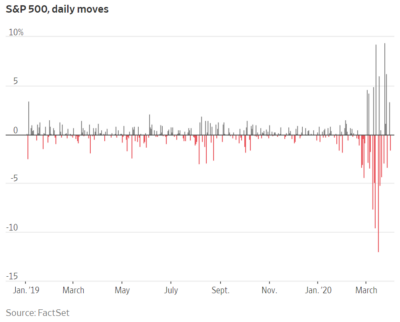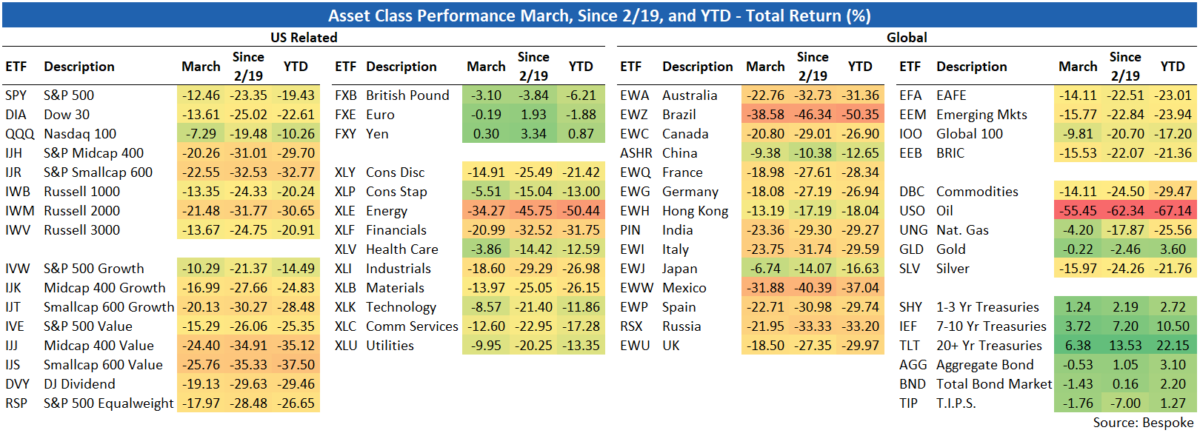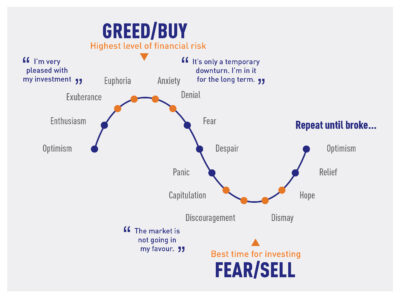

Dear Clients:
The term “unprecedented” is often misused/overused, but is certainly apropos to describe what would become the COVID-19 global pandemic and concomitant destruction of the world economy and financial/commodity markets. Unfortunately, the lead headline in the April 1, 2020 edition of The Wall Street Journal (“WSJ”), “Stocks End Worst Quarter in 12 Years,” wasn’t just a cruel April Fool’s joke. Still, we’ve been through many significant market declines over KM’s almost 45 years in business. While COVID-19 is new, surprises and economic shocks are not new to us. No matter the cause of the shock, our response is always the same—we seek opportunity in others’ fear.
The graph from the WSJ below illustrates the unprecedented volatility in the first quarter. From February 19 to March 23 (23 trading days), the S&P 500 suffered its most rapid meltdown in history, dropping a nauseating 33.9%. Of the 21 trading days between February 27 and March 27, 18 days saw moves in the S&P 500 of more than 2%; eleven down and seven up. They included the biggest daily percentage gain since 1933 (9.4% on March 24) and second-biggest percentage loss since 1940 (-12.0% on March 16, trailing only the -20.5% loss on “Black Monday,” October 19, 1987). In fact, the 10 largest daily percentage declines in the past two years for the S&P 500 all occurred between February 20 and the end of the first quarter.

The table from Bespoke Investment Group details the unprecedented damage to stocks and commodities in the first quarter. In addition, as shown in the illustration from J.P. Morgan, small-caps and mid-caps were both hit significantly harder than large-caps, while the Growth outperformed Value by a wide margin. Our investment discipline is Value and our holdings tend to be towards the mid-/small-cap end of the capitalization spectrum, which means we encountered the proverbial “perfect storm” in the first quarter.


We’ve established the first quarter was gruesome, so what’s the path forward? Stocks represent business ownership sliced into small pieces. We approach buying stocks by taking the perspective of owning 100% of the underlying business. The owner of the business is entitled to the future cash flows generated by the business. The intrinsic value of the business is simply the cumulative amount of those future cash flows, discounted back to today (i.e. the discounted present value of the future cash flows). We look for stocks priced well below our calculation of intrinsic value, with the intent of holding the stock/owning the business for 10 or more years.
Importantly, while stock prices can be extraordinarily volatile (like recently), the intrinsic values of the underlying businesses are much less so. In a February 24 interview on MSNBC, Warren Buffett said, “If you’re buying a business, and that’s what stocks are…you’re gonna own it for ten or 20 or 30 years. And the real question is has the ten-year or 20-year outlook for American business changed in the last 24 hours or 48 hours? You don’t buy or sell your business based on today’s headlines.” We’d ask, “If you owned a thriving family business for 20-years, would you sell it for dramatically less versus the beginning of the year simply because of COVID-19 fears?” We don’t think so.
We buy stocks when we believe they are trading at a significant discount to our calculation of the intrinsic value of the underlying business. We reject the notion anyone is smart enough to pick the market bottom, including us. In a seminal piece in the December 10, 2001 issue of Fortune, Buffett quoted his professor and mentor, Ben Graham: “Though the stock market functions as a voting machine in the short run, it acts as a weighing machine in the long run.” Buffett added, “Fear and greed play important roles when the votes are being cast, but they don’t register on the scale.” The illustration represents the cycle of Greed/Buy and Fear/Sell. We think we experienced the “Panic” phase in the first quarter and hope we’ll reach the “bottoming of the curve” sooner rather than later.

In Graham’s way of thinking, a company’s fundamentals are what counts and determines its stock price, in the long-run. With the economy essentially shut down, no business has been spared harm. In this topsy-turvy environment, we’ve been trying to determine if any companies we own have near-term survival risk and which are facing a temporary vs. permanent impairment of their business.
Forecasting short-term earnings is a futile exercise in this environment, but we have “stress-tested” each of our companies to determine if it can survive with zero revenue for six-months, looking at current sources of cash vs. minimum cash needs. In addition, for companies with publicly-traded bonds, we look at prices to see what fixed income investors believe. In a company’s capital structure, bonds are “senior” to equity/stock in regards to claims on the company’s assets/cash flow. If the company’s bonds are priced at 70 (vs. 100 “par value”), that says fixed income investors believe the company’s balance sheet is stressed.
We like what we own and are pleased company insiders have stepped up to purchase stock in the open market with their own money (vs. receiving grants of stock). Still, similar to prior shocks, we’re looking to use the decline as an opportunity to upgrade the quality of your portfolio (i.e. buying high-quality stocks we previously viewed as too expensive). We think after this transition, portfolios will have a slightly heavier large-cap component. Larger-cap stocks are typically viewed as financially more robust and have better trading liquidity vs. small-/midcap stocks and hence tend to hold-up better during crisis periods.
Bear markets (>20% drops) and corrections (10-20% drops) are normal parts of the investment landscape and what makes the “buy low” part of the equation possible. As shown in the lower right box of the Crandall, Pierce illustration, since the mid-1940s the S&P 500 has experienced 38 bear markets or corrections, once every 2 years. The lower middle box shows the average bear market decline has been -35.1% and took 16 months to reach bottom and about 3 ½ years to regain the prior peak. Thus, a quick, V-shape snapback to mid-February record levels would be unprecedented, but nothing about these past couple months has been “normal.”

We’ve included a copy of an excellent piece from Lord Abbett, “Riding Out Market Ups and Downs.” In sum, the message is:
- Stay calm. Stock market volatility is perfectly normal. Between 1980 and 2019, the S&P 500 experienced an average intra-year drop of 13.8% (peak-to-trough), yet had a positive return in 30 of 40 calendar years.
- Stay in. According to Lord Abbett, $10,000 invested in the S&P 500 on January 1, 1999 would have grown to $86,280 by December 31, 2019. However, “An investor who exited the market and subsequently missed just 10 of the best-performing days in those past 20 years would have lost out on more than half of the gains (growing instead to only $43,059).” Further, “Given the difficulty of market timing (six of the 10 best days occurred within two weeks of the 10 worst days), a far better course would have been to stay in, with the knowledge that volatility is normal and that missed upside can dramatically cut into long-term returns.” We acknowledge this is very difficult during a downdraft. As pugilist Mike Tyson famously said, “Everyone has a plan until they get punched in the mouth.”
- Stay the course. For long-term investors, time is on your side and time in the market is more important than timing the market. Historically, the longer you stay in the market, the greater the probability for a positive outcome. According to Crandall Pierce, for rolling periods between January 1950 and March 2020, one-year returns for the S&P 500 were positive 79% of the time (range of -43.3% to 61.2%), five-year returns were positive 92% of the time (-6.6% to 29.6%) and 10-year returns were positive 97% of the time (-3.4% to 19.5%).
We are subscribers to The Behavioral Finance Network and fans of proprietor Jay Mooreland. It seems like everyone has been focused on the physical/financial aspect of the crisis (rightly so), but Jay recently posted a piece about how the mental aspect is also important. We thought you might enjoy reading and he’s given us permission to share.
KM Team Update
- Maggie and husband Kyle welcomed their first child, Jackson David, on January 15. Jackson couldn’t wait to make his appearance, so was born 8 weeks early. He hung out with the doctors and nurses at Peyton Manning Children’s Hospital for his first 10 weeks, but is now home and doing fantastic. Congrats, Maggie and Kyle!

- Mary Jo Cusano retired at the end of 2019, following a distinguished 27-year career as a key member of KM’s Administrative Team. She now splits her time between Chicago and Phoenix visiting her sons and grandchildren. We miss you, Mary Jo!
- Kathy Burnett joined KM last June as Mary Jo’s replacement. Kathy is delightful and was previously with our local newspaper, The Republic, for more than 22 years, most recently as the Operations Manager of the Advertising Department. Welcome, Kathy!
- Donna Katheeder joined KM in 2012 as a member of KM’s Administrative Team. Donna was previously with Indiana Bank & Trust and recently received a “battlefield promotion” to Office Manager because of her organizational skills and dedication to our clients, most recently during the COVID-19 pandemic. Congrats, Donna
Regulatory Update
Kirr, Marbach & Company, LLC (KM) is registered with the U.S. Securities and Exchange Commission (“SEC”), which requires advisers to file Forms ADV-Part 1 and 2A (“Brochure”)/2B (“Brochure Supplements”) electronically on the Investment Adviser Registration Depository (www.iard.com). KM filed its Forms ADV-Parts 1, 2A and 2B on March 23, 2020. Part 2A is a narrative disclosure of an adviser’s business, written in “plain English.” The SEC mandated the headings, specific topics to be covered and the order of presentation.
Regards,
Kirr, Marbach & Company, LLC
Past performance is not a guarantee of future results.
The S&P 500 Index is an unmanaged, capitalization-weighted index generally representative of the U.S. market for large capitalization stocks. This index cannot be invested in directly.
Subscribe
Subscribe to stay up to date with the latest news, articles and newsletters from Kirr Marbach.












